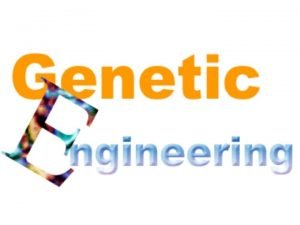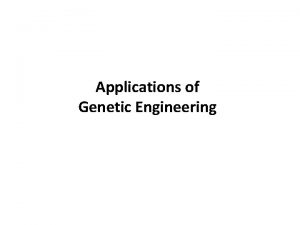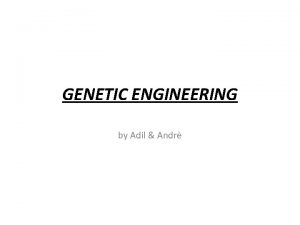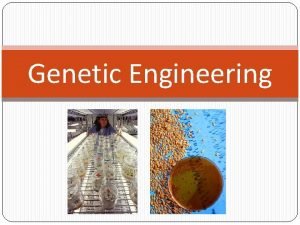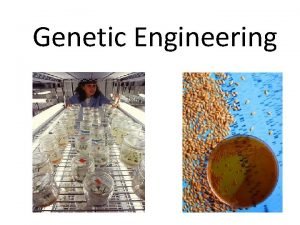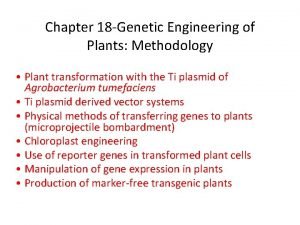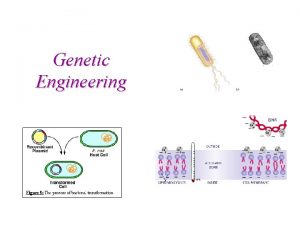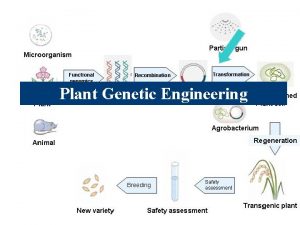Chapter 10 Genetic Engineering of Plants Methodology Plant


















- Slides: 18

Chapter 10 – Genetic Engineering of Plants: Methodology • Plant transformation with the Ti plasmid of Agrobacterium tumefaciens • Ti plasmid-derived vector systems • Microprojectile bombardment • Chloroplast engineering • Use of reporter genes in transformed plant cells • Manipulation of gene expression in plants • Production of marker-free transgenic plants

Why genetically engineer plants? • To improve agricultural, horticultural or ornamental value of a plant (much faster than conventional plant breeding) • To serve as a living bioreactor for production of economically important proteins or metabolites • To produce vaccines or antibodies for human health • To provide a renewable source of energy • To study the role of genes (and gene products) in plant growth and development

Chapter 10 Genetic Engineering of Plants: Methodology Table 10. 1 Molecular Biotechnology: Principles and Applications of Recombinant DNA, Fifth Edition Bernard R. Glick, Cheryl L. Patten Copyright © 2017 ASM Press American Society for Microbiology 1752 N St. NW, Washington, DC 20036 -2904

Chapter 10 Genetic Engineering of Plants: Methodology Table 10. 2 Molecular Biotechnology: Principles and Applications of Recombinant DNA, Fifth Edition Bernard R. Glick, Cheryl L. Patten Copyright © 2017 ASM Press American Society for Microbiology 1752 N St. NW, Washington, DC 20036 -2904

Chapter 10 Genetic Engineering of Plants: Methodology Table 10. 3 Molecular Biotechnology: Principles and Applications of Recombinant DNA, Fifth Edition Bernard R. Glick, Cheryl L. Patten Copyright © 2017 ASM Press American Society for Microbiology 1752 N St. NW, Washington, DC 20036 -2904

Chapter 10 Genetic Engineering of Plants: Methodology Figure 10. 1 Genetic engineering of plants with the Ti plasmid of Agrobacterium tumefaciens, a soil bacteria. A. Infection of a wounded plant by Agrobacterium tumefaciens leads to the production of a crown gall tumor (cancer) B. The Ti plasmid of Agrobacterium tumefaciens C. Wound signals produced by the plant to induce expression of the vir genes on the Ti plasmid D. T-DNA right and left border nucleotide sequences involved in transfer of the T-DNA into the plant genome See also https: //www. youtube. com/watch? v =w. TO-Kmp. ZQg. Q Molecular Biotechnology: Principles and Applications of Recombinant DNA, Fifth Edition Bernard R. Glick, Cheryl L. Patten Copyright © 2017 ASM Press American Society for Microbiology 1752 N St. NW, Washington, DC 20036 -2904

Crown Gall on Tobacco Infection of a plant with Agrobacterium tumefaciens and formation of crown galls

Chapter 10 Genetic Engineering of Plants: Methodology Figure 10. 3 Chemical structures of three opines (amino acid-like molecules) produced by T-DNA genes expressed in an infected plant; opines are used as food by A. tumefaciens. Molecular Biotechnology: Principles and Applications of Recombinant DNA, Fifth Edition Bernard R. Glick, Cheryl L. Patten Copyright © 2017 ASM Press American Society for Microbiology 1752 N St. NW, Washington, DC 20036 -2904

Plant Genetic Engineering with the binary Ti plasmid System Clone YFG (your favorite gene) or a Target gene in the small T-DNA-like plasmid in E. coli, isolate this plasmid, and use it to transform A. tumefaciens which already contains a disarmed Ti plasmid. The disarmed Ti plasmid lacks a functional T-DNA region. This is a binary system as it involves 2 plasmids. Note that the vir genes on the disarmed Ti plasmid serve to move the T-DNAlike region of the small plasmid into the plant genome, resulting in random integration into the plant genome. See also https: //www. youtube. com/watch? v=L 7 q n. Y_Gqyt. M (disarmed) Transgenic plant

Chapter 10 Genetic Engineering of Plants: Methodology Figure 10. 6 Using Microprojectile Bombardment (Biolistics) to shoot genes into plants, either into the plant nuclear genome or the plant chloroplast genome. Molecular Biotechnology: Principles and Applications of Recombinant DNA, Fifth Edition Bernard R. Glick, Cheryl L. Patten Copyright © 2017 ASM Press American Society for Microbiology 1752 N St. NW, Washington, DC 20036 -2904

Chapter 10 Genetic Engineering of Plants: Methodology Figure 10. 8 A. Gene constructions for: A. Expression of a foreign (or target) gene in the nucleus and targeting of the foreign protein to the chloroplast and B. Expression of a foreign (or target) gene in the chloroplast Chloroplastspecific Promoter Molecular Biotechnology: Principles and Applications of Recombinant DNA, Fifth Edition Bernard R. Glick, Cheryl L. Patten Copyright © 2017 ASM Press American Society for Microbiology 1752 N St. NW, Washington, DC 20036 -2904

Chapter 10 Genetic Engineering of Plants: Methodology Table 10. 5 http: //www. youtube. co m/watch? v=Sl 2 PRHG p. Yu. U Molecular Biotechnology: Principles and Applications of Recombinant DNA, Fifth Edition Bernard R. Glick, Cheryl L. Patten Copyright © 2017 ASM Press American Society for Microbiology 1752 N St. NW, Washington, DC 20036 -2904

Chapter 10 Genetic Engineering of Plants: Methodology Figure 10. 14 When expressing a target gene in plants, one needs to consider which plant promoter/enhancer sequence to use as this will determine where, when, and how much m. RNA (and protein) is produced. Molecular Biotechnology: Principles and Applications of Recombinant DNA, Fifth Edition Bernard R. Glick, Cheryl L. Patten Copyright © 2017 ASM Press American Society for Microbiology 1752 N St. NW, Washington, DC 20036 -2904

Manipulation of gene expression in plants: Choosing the right promoter/enhancer sequences to express your target gene • Strong, constitutive promoters (35 S Cauliflower mosaic virus promoter or 35 S Ca. MV or 35 S) • Organ and tissue specific promoter (e. g. , the leaf-specific promoter for the small subunit of the photosynthetic enzyme ribulosebisphosphate carboxylase or rbc) • Promoterless reporter gene constructs to find new organand tissue-specific promoters • Inducible promoters (Dex or dexamethasone) • Synthetic promoters

Other DNA modules or genes to consider adding when expressing your target gene in plants • Protein affinity tag sequences to facilitate purifying your target protein from plants (e. g. , c-myc, FLAG, 6 x. His, olesins [oil body proteins]) • Protease recognition sequences to remove affinity tags • Signal peptide sequences to facilitate secretion of your target protein outside the cell (e. g. , Rhizosecretion or secretion of your target protein by plant roots by using a a signal peptide sequence along with a root-specific promoter and growing the transgenic plant hydroponically (your target protein will be secreted into the hydroponic growth media) • Cellular targeting sequences (nucleus, cell wall, ER, Golgi, mitochondria, chloroplasts, etc. ) • Genes which modify or inhibit certain plant protein glycosylation reactions to produce therapeutic glycoproteins with more humanlike glycosylation

Chapter 10 Genetic Engineering of Plants: Methodology Figure 10. 16 Fusing your target protein to oleosin (an oil body protein) to facilitate target protein purification. Molecular Biotechnology: Principles and Applications of Recombinant DNA, Fifth Edition Bernard R. Glick, Cheryl L. Patten Copyright © 2017 ASM Press American Society for Microbiology 1752 N St. NW, Washington, DC 20036 -2904

Chapter 10 Genetic Engineering of Plants: Methodology Figure 10. 17 Expressing your target protein for secretion by the roots in a hydroponic system by a process called “rhizosecretion” Molecular Biotechnology: Principles and Applications of Recombinant DNA, Fifth Edition Bernard R. Glick, Cheryl L. Patten Copyright © 2017 ASM Press American Society for Microbiology 1752 N St. NW, Washington, DC 20036 -2904

Chapter 10 Genetic Engineering of Plants: Methodology Figure 10. 21 Removal of selectable marker sequences to produce “Marker-Free Transgenic Plants” to address potential human, animal, or environmental safety concerns. This can be done using A. A transposase gene and Ds elements surrounding the selectable marker or B. A recombinase gene and recombinase recognition sequences surrounding the selectable marker and the recombinase gene. Molecular Biotechnology: Principles and Applications of Recombinant DNA, Fifth Edition Bernard R. Glick, Cheryl L. Patten Copyright © 2017 ASM Press American Society for Microbiology 1752 N St. NW, Washington, DC 20036 -2904
 Genetic drift definition
Genetic drift definition Genetic programming vs genetic algorithm
Genetic programming vs genetic algorithm Genetic programming vs genetic algorithm
Genetic programming vs genetic algorithm A gene pool consists of
A gene pool consists of Gene flow vs genetic drift
Gene flow vs genetic drift Production of insulin
Production of insulin Genetic engineering
Genetic engineering Genetic engineering applications
Genetic engineering applications How is selective breeding accomplished
How is selective breeding accomplished Purpose of genetic engineering
Purpose of genetic engineering Genetic engineering conclusion
Genetic engineering conclusion Oryx and crake genetic engineering
Oryx and crake genetic engineering Pro genetic engineering
Pro genetic engineering Ethical issues of genetic engineering
Ethical issues of genetic engineering Bioluminescence genetic engineering
Bioluminescence genetic engineering Objectives of genetic engineering for class 10
Objectives of genetic engineering for class 10 Agrobacterium tumefaciens genetic engineering
Agrobacterium tumefaciens genetic engineering Genetic engineering
Genetic engineering Algenol
Algenol





